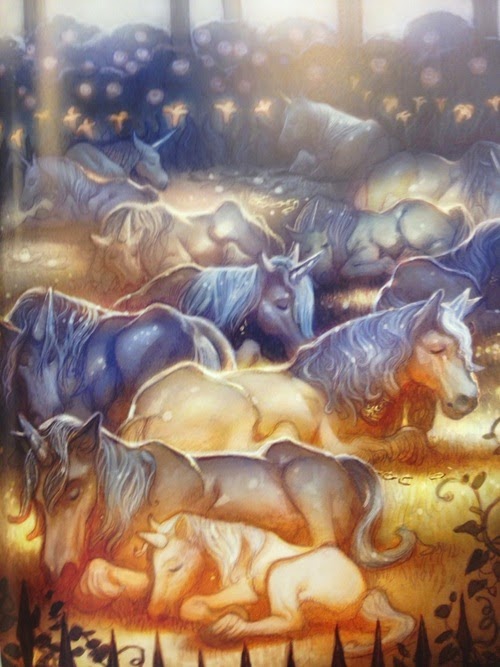Breyer's Great Horse in Armor (St. George and the Dragon theme)
Okay, remember the Fairy Tale Blogger posts from a few months ago:
You Know You're a Fairy Tale Blogger When....? A common theme was of the "too much to cover, not enough time" variety. Here is where I show my knickers and admit that the following post(s)--since part 2 will be tomorrow--have been sitting in my inbox mocking me for TWO years now.
SurLaLune readers--as you know since you are here reading here--are a very generous bunch. One of the cream of the crop is Christine Ethier who shared a
Fairy Tale Gifts post a few years ago in which she mentioned fairy tale themed Breyer Horses. I wanted to know more. She shared. I've let her work sit for years in my inbox. You'd think I was a traditional book publisher instead of a blogger with instantaneous publication abilities, wouldn't you?
But in this case, better late than never. So today I will share part 1 in which Christine shares information about Breyer Horses in general and fairy tales specifically. Tomorrow I will share a bit more with images about the Breyerfest 2011 which had a fairy tale theme.
From Christine Ethier:
Breyer Animal Creations was born in 1950. The first model produced was the Western Horse. The model appeared as part of a clock for Mastercrafter Clock Company. The model was then produced for Woolworth’s where it sold well. In 1984, the company was brought by Reeves International, Inc. Production and headquarters were moved to New Jersey, with some production being moved to China in 2001. Before the model is produced, an artist sculpts a clay statue. Then resin prototype models are produced, followed by metal molds. The model as sold in stories is made using ABS or Cellulose Acetate (a process that leaves some models with air holes). Most of the paint is airbrushed on, though depending on the type of model or horse produced, there may be hand painting done.
Collectors of Breyer models use various terms. Two of the most important for this article are Mold and Model. The term mold refers to the style of a model, not the paint job, but how the horse stands. The mold number is usually the first horse done in that style. Model refers to actual number assigned to the piece by the company. Mold numbers are also used before the abbreviation SR, Special Run. Therefore, 496SR, means mold 496 in a Special Run, a model that was produced only for a certain time, event, or company.
In 2004, Breyer released Romance (#1224). The model shows two scenes that seem to be inspired by “Cinderella”. Romance was produced on the Huckleberry Bey (a famous Arabian stallion) mold (#472) and was sculputed by Kathleen Moody. This was produced until 2006.
Side A
Side B.
In starting in 2003, Breyer released some Stablemate sets that have fairy tale themes. The first is Fantasy Breyer set. (Model #5911, produced only in 2003). The horse is the G2 Rearing Arabian by Kathleen Moody.
The second is the Medieval Play Set, which was produced in 2003-2004 and numbered 5910. The horse is the G2 Clydesdale by Kathleen Moody. Note the knight is a woman.
The third is #5989 Princess and Carriage Play set, which ran from 2004-2005. The adult horse is G2 Andalusian; the foal is G1 Thoroughbred Lying Foal sculpted by Maureen Love Calvert.
A quick word about pricing.
The price of a particular model is determined by a variety of factors. The most obvious is the condition of the model. A model that is extremely old is not going to fetch as much money if the condition is extremely bad. Collector’s usually grade models on a scale of 4 to 1, with 4 being near prefect. Additionally the term LSQ is used. LSQ stands for Live Show Quality, which means the model is relatively free of imperfections (a mistake in the paint job for example) and damage (which is anything from a rub or broken piece). Current production models tend to run anywhere from just over three dollars (for Stablemates) to over 100 dollars for Special Runs models sold though Breyer’s website. The average price for a traditional model is 25-35 dollars.
In regards to retired (no-longer produced) models (which are most of the models in this overview), the cost will vary. Outside of condition, the mold, rarity, artist, and paint job affect the mold. Popular molds include Silver, Spirit, and the American Saddlebred Stallion. Models produced for sale at Breyerfest (the yearly convention) tend to be more expensive right after the event, and then level off in about a year. The most expensive models on the resale market tend to be either Raffle models (usually 25 or under of a model), Connoisseur Models , Presentation Models (older models on a wooden or plastic base) , or older decorator models (models with a gold or blue paint job). These models can run in the 100s of dollars. Always compare prices before buying.
Breyer’s earliest forays into fairy tale horses, were simply fantasy horses. Over the years, Breyer has produced several unicorns and Pegasus models in various lines. In most cases, the unicorn or the Pegasus was made at of basic mold and then given a horn or wings. The only original sculpture was the Little Bit Unicorn 9020 (below). The mold made its debut in 1984. The sculpture is by Chris Hess. The mold has been used for seven models, including two special runs.
All images in this post are courtesy of Christine Ethier.












































